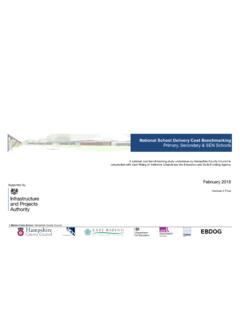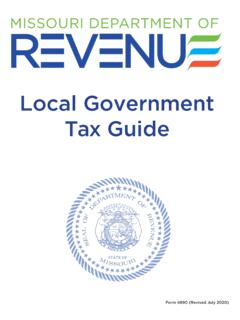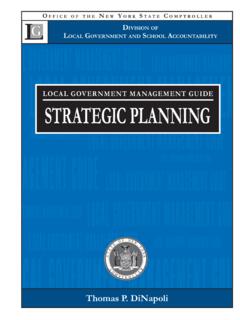Transcription of Local government workforce: a guide to pay benchmarking
1 Local government workforce: a guide to pay benchmarkingSeptember 2011 WorkforceContentsExecutive summary 3 Introduction 5 Chapter 1: Evaluate 9 Chapter 2: Classify 11 Chapter 3: Compare 14 Chapter 4: Adjust 17 Chapter 5: Monitor 22 Further information and tools 23 Produced by the Local government Group in partnership with the Audit CommissionA guide to pay benchmarking3 This paper is intended as a guide for practitioners intending to benchmark their authority.
2 Pay benchmarking is a process of collecting data on the compensation for similar jobs in other organisations to establish their market rate and track movements in those rates. One of the primary goals when setting the level of remuneration for a job is to match it to the market rate . In simple terms this means paying enough so that you can easily recruit and retain your staff, while not paying more than you have to (which would have an inflationary and detrimental effect on budgets). Pay benchmarking can be understood as following five stages, summarised in the figure below.
3 Executive summary Define purpose and objectives Identify resources Clarify role of job evaluation in your process Select approach and process for benchmarking Define relevant metrics Monitor success of project Implement monitoring processes to ensure reflection of changing market rates Adjust pay to eliminate significant differences from market rates Produce total rewards statements Select relevant benchmark companies and organisations Identify suitable data sources and collect data Undertake gap analysisEvaluateClassifyCompareAdjustMon itor4 A guide to pay benchmarkingWhen undertaking a benchmarking project the following advice should be considered.
4 Define measurable aims and objectives that you can then assess once the process is complete be clear about the role that job evaluation will play in your benchmarking and understand the tension it creates with market rates when choosing your approach, understand your requirements for accuracy and the burden in data collection that these will create benchmarking is as much an art as a science; do not get too distracted by the pursuit of accuracy benchmark against basic pay only, and then account and adjust for other rewards benchmark based on labour market nearest neighbours and not region or authority type identify the data sources most suitable to your needs.
5 Be aware of the level of detail required pay benchmarking is essentially a gap analysis of your pay compared to the wider market produce a total rewards statement to help you and the employee understand the complete value of the rewards on offer market supplements can be used to adjust to external market rates without affecting internal equality use a simpler benchmarking approach for monitoring change over time. A guide to pay benchmarking5 This paper is intended as a guide for practitioners wishing to benchmark pay in their authority.
6 It starts by outlining what benchmarking is, and why an authority may want to benchmark their pay. It goes on to suggest a process that authorities can follow in their approach to benchmarking and examines what elements of rewards should be included in this process. It also suggests that instead of comparing by authority type or region, as is commonly the case, practitioners should benchmark against a new model that more accurately reflects the characteristics of labour markets. In summary this paper covers: why authorities should benchmark their pay and rewards how pay should be benchmarked what authorities should be comparing who authorities should benchmark is benchmarking ?
7 benchmarking is the process of comparing one organisation s processes and performance with: a peer group (eg of similar councils or organisations) with the best in the sector with best practice in other bodies operating in completely different sectors (such as the private or not-for-profit sectors) yourself in previous years (to gather trend data).It is a learning tool, with the aim of doing things better, faster, or cheaper. This paper focuses on pay benchmarking but the principles and process outlined below are applicable to benchmarking more generally.
8 Pay benchmarking specifically is a process of collecting data on the compensation for similar jobs in other organisations to establish their market rate and track movements in those rates. The aim of this process is to help set the organisation s own pay rates at the appropriate level in order to recruit and retain the staff it needs without paying more than necessary. The benchmarking process involves five stages, which will be dealt with in individual chapters: evaluate classify compare adjust A guide to pay benchmarkingThe benefits of pay benchmarkingOne of the primary goals when setting the level of remuneration for a job is to match it to the market rate.
9 In simple terms this means paying enough so that you can easily recruit and retain your staff, while not paying more than you have to (which would have an inflationary and detrimental effect on budgets). To determine the prevailing rate for a job, organisations can benchmark jobs against data from other organisations and industries, comparing the rates of pay offered for similar jobs. In the private sector jobs are often valued using a market pricing approach. With the market pricing approach, people are compensated in relation to the market value of their job, regardless of their level in the organisation.
10 Within Local government , jobs are required to meet internal equality standards, so that similar jobs are compensated at similar levels. This can create a tension between the need to meet equalities duties and the desire to target pay at the right rate for the market (although as we will see later this can be overcome through the use of market supplements). Despite this tension, pay benchmarking remains one of the single most important elements of accurately assessing the levels of pay that an organisation should offer.














